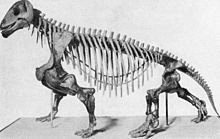Moschops
| Moschops | ||||||||||||
|---|---|---|---|---|---|---|---|---|---|---|---|---|

Drawing-life reconstruction of Moschops capensis |
||||||||||||
| Temporal occurrence | ||||||||||||
| Upper Perm | ||||||||||||
| approx. 255 million years | ||||||||||||
| Locations | ||||||||||||
| Systematics | ||||||||||||
|
||||||||||||
| Scientific name | ||||||||||||
| Moschops | ||||||||||||
| Broom , 1911 | ||||||||||||
| Art | ||||||||||||
|
Moschops ( Greek. Calf Face of μόσχος " calf " and ὄψ " Face, Eye ") is an extinct genus of dinocephalia . The Moschops fossilscome from the Upper Permian of South Africa and are dated to an age of 255 million years . The remains of the only known species, Moschops capensis , were first described by Robert Broom in 1911.
features
Moschops was two and a half meters long. The rib cage was very large with 25 paired ribs. The limbs were strong, the feet were relatively small. The hind legs were already held directly under the body, similar to that of mammals , but the front legs spread apart from the body, as with the " reptiles ". The head of the animal was very small compared to its size; this is still reminiscent of the herbivorous pelycosaurs . The muzzle was rounded, but the rear part rose to form a broad, massive structure. The roof of the skull was up to 10 cm thick. However, it was not as strongly curved as in the close relative Tapinocephalus .
Discovery story
Moschops fossils were first found by Robert Broom in the Ecca Group (part of the Karoo supergroup ) in South Africa. The stratigraphic assignment was uncertain, but since Pareiasaurus fossils were found nearby , the assignment seems likely. The fossils include a holotype (AMNH 5550) and seven typotypes (AMNH 5551-5557). The skulls of the specimens are thickened differently, according to Broom this is due to different genders / age groups. The specimens were sent to the American Museum of Natural History in New York in 1910 and described in 1911.
Systematics
Moschops is a dinocephalia . It belongs to the family of the Tapinocephalidae , whose sister taxons are the Titanosuchidae . Both are summarized as Tapinocephalia and Titanosuchia .
Paleobiology
Moschops had chisel-shaped, blunt teeth with which he tore off and crushed his vegetable food. It is believed that moschops grazed low vegetation in small herds.
Pachyostosis
The roof of the animal's skull was thickened ( pachyostosis ). It was probably used for head butting, similar to sheep , goats or the pachycephalosaurs . The main force of the impact hit the thickened dorsal shield of the skull and was transmitted over the sides to the thick articular knot of the occipital bone (condylus occipitalis), which is well below the skull. The knot was exactly on the line connecting the spine and the point of impact on the roof of the skull. The thrust was then directed to the cervical spine and transferred to the strong shoulder region.
swell
- Gregory William: The skeleton of Moschops capensis, a dinocephalian reptile from the Permian of South Africa . In: Bulletin of the American Museum of Natural History . tape 56 , no. 3 , 1926, pp. 179-251 ( online ).
- Michael J. Benton: Paleontology of the vertebrates. 2007, ISBN 3-89937-072-4 , pp. 139 to 140
Individual evidence
- ^ Gregory William 1926 p. 187
- ↑ Gregory William 1926 p. 181
- ^ A b Robert L. Carroll: Paleontology and evolution of the vertebrates. Thieme-Verlag, Stuttgart, 1993, ISBN 3-13-774401-6
- ^ Thomas S. Kemp: The Origin & Evolution of Mammals. Oxford University Press, Oxford 2005. ISBN 0198507615 .
- ↑ Steven Parker: Dinosaurs ; 2004, Weltbild publishing group; ISBN 3828960316 ; P. 108.
- ↑ John Malam, Steven Parker: The Empire of the Dinosaurs ; 2003; Scriptorium, Cologne; ISBN 1-40541-317-4 ; P. 31.

